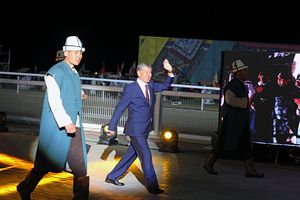Friday, Kyrgyz President Almazbek Atambayev signed into law constitutional changes approved in a referendum in early December. Many of the changes were controversial — with the Venice Commission, a European advisory body consisting of independent constitutional law experts, most notably lobbing heavy criticisms on an draft of the changes. The commission’s preliminary joint opinion, issued in late August 2016, said the proposed changes would “negatively impact the balance of powers.”
Nevertheless, the December 11 referendum — a straight-up yes or no vote on the package of about 40 amendments — passed soundly. As I wrote at the time, for many observers the rebalancing of powers between the president and prime minister was deliberate: either Atambayev is envisioning “a Putinesque term as prime minister when his single presidential term concludes” (which he denies) or he’s interested in empowering a loyal colleague in the office.
There are various reasons Atambayev would want to pursue such a path, ranging from a basic autocratic bent many of his critics accuse him of possessing, to the pragmatic conclusion that there are no former Kyrgyz leaders who have not been pursued or criticized in some fashion or another by their successors. Often that criticism has been matched with prosecution for corruption and other crimes.
Kyrgyzstan’s next presidential election is slated for October. In a region known for predictable electoral outcomes, the fall presidential poll in Kyrgyzstan presents a genuine uncertainty. Or at least it seems to. Atambayev’s former party, the Social Democratic Party (SDPK) — presumably to which he’ll return after his term is completed — holds the most parliamentary seats, and at this juncture is best poised to supply a presidential successor.
The momentous election will be a time of great vulnerability. Kyrgyz — unlike publics in neighboring states — have demonstrated twice in the last 12 years their willingness to forcibly press the “reset” button on the government. In 2005 and 2010, public protests grew into revolutions with presidents — Akayev and Bakiyev — squeezed from power.
Atambayev knows his predecessors’ histories and would be a fool to not contemplate their fates. There’s nothing deterministic about that history, but the fractures that led to previous revolutions remain a feature of Kyrgyz democracy.
The Tulip Revolution of 2005, which forced out President Askar Akayev — who had been the country’s president since 1990 — began after parliamentary elections. There were many factors building to the events of 2005, but the election was a significant spark. Pro-Akayev candidates fared well and the vote was deeply criticized both locally and from abroad. Kurmanbek Bakiyev, leader of an electoral alliance — the People’s Movement of Kyrgyzstan — joined protesters in Bishkek and marshaled opposition parties against the country’s first president.
Bakiyev’s ouster five years later was not presaged by a botched election, but economic turmoil, nepotism, and rising tensions between ethnic Kyrgyz and Uzbeks. The Bakiyevs, since fleeing the country, have been hounded by the Atambayev government — charged and convicted in absentia.
Kyrgyzstan’s interim president in 2010 — Roza Otunbayeva — has also been subject to attacks on her character and record during her short term leading the country before Atambayev’s election. Atambayev himself led that charge. During Kyrgyzstan’s 25th independence day celebrations last August, Atambayev heaped enough harsh commentary on Otunbayeva during remarks in Ala-Too Square that she stormed off the stage.
It will take time for the significance of the constitutional changes, especially those rebalancing power within the government, to become clear. The election this fall will be a major milestone.

































